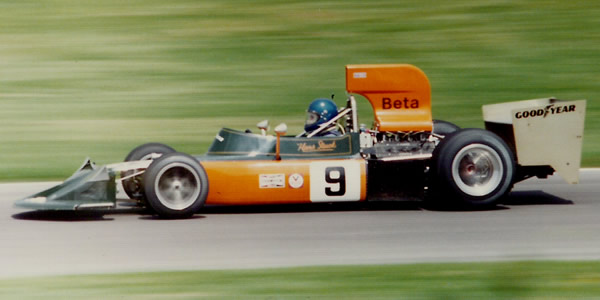March 741 car-by-car histories

Hans Stuck in his March 741 at the 1974 British GP. Copyright Richard Bunyan 2007. Used with permission.
Although Hans Stuck and Vittorio Brambilla threatened to revitalise March with the March 741, a lack of finance and reliability left the team only ninth in the championship.
After the failure of the March 731, a development of the March 721G, Robin Herd went in a new direction for the 1974 F1 car. He started with the monocoque and basic suspension layout of the highly-successful March 732 Formula 2 car but returned to the idea of mounting the radiators at the sides. The nose was again full width, but now more a chisel shape instead of the bluff ‘sports car’ nose of the 732, and the oil radiator was moved to the tail, attached to the enormous endplates of the 741’s “box kite” rear wing. With no major sponsorship deal in place, the cars were finished in British Racing Green.
Jean-Pierre Jarier and Mike Beuttler were due to drive for March in F1, but Jarier was lured away by Shadow and Beuttler could not secure the necessary sponsorship, so attention turned to 22-year-old touring car star Hans-Joachim Stuck, a protégé of BMW racing boss Jochen Neerpasch, who arranged sponsorship from Jägermeister. Howden Ganley drove the second car, but he was replaced after two races by Vittorio Brambilla, who brought crucial sponsorship from Beta. Stuck was impressive, taking fifth place in South Africa, then fourth in Spain when his stop to change to dry tyres was perfectly timed. Brambilla’s 741 was wrecked in Spain when a brake hose was severed, and his car was rebuilt on a new monocoque as 741/2-2. Stuck’s car also needed a new monocoque after a crash at Monaco, emerging at the Swedish GP as 741/1-2; then it was the Italian’s turn at the French GP when a wheel centre pulled out. While Brambilla’s car got a new tub to become 741/2-3, that French GP tub was repaired and used to rebuild Stuck’s car after he crashed during practice for the British GP, making it 741/1-3. The final rebuild came after Brambilla crashed in practice at the Canadian GP, so his car ended the season as 741/2-4. So that’s two cars, but seven entities involving a maximum of six monocoques.
Race
Starts
Prix
Starts
Prix
Wins
One of the 741s were used again at the start of the 1975 season by Brambilla in South America and then by new driver Lella Lombardi in South Africa before the new March 751s were ready. After that, Brambilla's 741/2 was sold to Jean Blanc for the Swiss national championship, and Stuck's 741/1 was sold to Sir Nick Williamson for the British hillclimb championship. Each car has a solid provenance through to the present day.
Hewland DG300 or Hewland FG400
By 1974, nearly all F1 cars used Hewland's newer and lighter FG400 gearbox. The last car to be built for the DG300 had been the McLaren M19A in 1971, but even those cars were converted to the FG400 in 1972. The only times since then that a DG300 had been used in F1, even briefly, was on the March 731 and the Connew, and those appear to have been budgetary reasons. The reason that the March 741 was built for the DG300 was because the huge box wing on the 741 was expected to generate so much downforce that the lighter FG400 might not have been strong enough to support it. So the elaborate supporting structure fabricated for the wing was designed to fit onto the DG300, not the FG400. All photographs found of March 741s right up to the model's final appearance in South Africa in 1975 show a DG300 gearbox. Only when 741/1 was sold for hillclimbing in Britain was it converted to use an FG400 gearbox with a March 751 rear wing. This has proved a problem for anyone wanting an FIA HTP to race a 741 in historic racing with an FG400, and there have been several lengthy attempts to prove that a 741 was raced with an FG400. It wasn't.
Extra March 741s
It should be noted that the two authentic March 741s shown above are not the only March 741s currently in existence. Two other cars have been built up from 1974-type March tubs of unknown provenance. The first of these has its origins in a March 73A that appears to have been rebuilt on a 74A tub in 1974. It was last seen in Australia when it had a FG gearbox and 751 rear wing, and wore a plate claiming it to be "741-1B", but it is rumoured to have moved to the US. The other was built on a tub that can be traced back to an American Formula Atlantic racer, who is said to have acquired it when racing in England. This car has been raced in European Masters and TGP events and is claimed to be "741-2".
If you can add to our understanding of these cars, or have photographs that we can use, please email Allen at allen@oldracingcars.com.
These histories were last updated on .